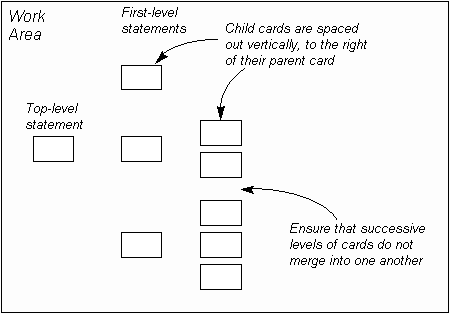Tree Diagram: How to do it
The Quality Toolbook >
Tree Diagram > How to do it
When to use it | How to understand it |
Example | How to do it | Practical
variations
<-- Previous |
Next -->
How to do it
- Identify the objective of using the Tree Diagram. Examples of this include:
- Determine the individual tasks that each person on a project team must carry out to achieve a known objective.
- Describe all sub-assemblies and basic components in a competitor's product.
- Identify a customer's basic needs of a product.
- Determining the root causes of a problem.
- Assemble a small team of people to work on the diagram. These people should be of an analytical (rather than creative) nature, and should have sufficient subject expertise between them to be able to break down the problem to the required level of detail.
- Define the top-level 'root' statement. This should be a brief phrase which
clearly describes the problem at this level, making it easier to identify its
individual sub-components. For example, 'Deliver Requirements Proposal'.
This statement may be derived from the use of another tool. Thus it may be the key cause in a Relations Diagram or the top-level header card in an Affinity Diagram.
Write this statement on a 3" x 5" card and place it on the middle-left of the work area, visible to all team members.
- Define the process for breaking down each 'parent' statement into 'child' statements. This can be helped by defining a question to ask of the parent statement, based on the original objective defined in step 1. Possible questions to ask include:
- What must be done to achieve the parent statement?
- What are the physical parts of the parent?
- Why does the parent happen?
Typically, the child should have a direct (and not distant) relationship with the parent. For example, 'component breakage' may be a direct cause of 'machine failure', rather than 'metal fatigue', which causes the component to break.
This process may also include questions to ask that ensure the child statements together make up a fair representation of the parent statement.
- Define the criteria to be used to identify when bottom-level 'leaves' have been arrived at, and the problem does not need to be broken down further. For example, 'Tasks that may be allocated to a single person, and will take no more than one week each to complete'.
- Apply the process defined in step 4 to the top-level statement from step 3, in order to produce the first-level child statements (although if the top-level statement was derived from another tool, then it may be reasonable to also derive the first-level child statements from the same place).
Write these statements on 3" x 5" cards, and arrange them to the right of the top-level statement card, as below.

Fig. 1. Arranging the cards
In many situations, each parent may be expected to have around two to four children. Having one child is often reasonable, but having many children, particularly at the higher levels, can result in an awkward and unmanageable diagram. If this happens, ask whether some of the children should be appearing at a lower level
.
- Repeat this process for each card in the first level, first checking whether the criteria defined in step 5 indicates that further breakdown is required. Arrange the child cards to the right of their parents, ensuring that family groups do not merge.
- Continue to repeat the process until the criteria defined in step 5 are met and no further breakdown is required. If cards become cramped together, take time to rearrange them such that all parent-child relationships between cards are clear.
- When the diagram is complete, review the stages, looking for improvements, such as:
- Statements which are in the wrong place, for example where enthusiasm at early levels has resulted in statements that should be lower down the tree.
- Levels where the child statements together do not represent their parent very well.
- General imbalances in the tree, for example where an understood subject is pursued in detail at the expense of other subjects.
Where improvements are found, rearrange the cards or repeat the process as appropriate.
- Use the completed tree to help achieve the objective as identified in step 1.
<-- Previous |
Next -->
|